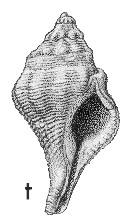
Revised descriptions of New Zealand Cenozoic Mollusca from Beu and Maxwell (1990)

 | Revised descriptions of New Zealand Cenozoic Mollusca from Beu and Maxwell (1990) | 
|
  (Pl. 20t): GS9700, J38/f9681, Sutherlands, Tengawai River, Altonian (GNS) |
Beu & Maxwell (1990): Chapter 11; p. 194; pl. 20 t.
Synonymy: Fusus tegens Hutton 1877b, p. 594; Fusinus tegens; Fusinus congestus Suter 1917, p. 21-22
Classification: Muricidae: Trophoninae ?
Description: Size moderate for family (height 15-20 mm), fusiform, spire 0.3 total height. Protoconch small, mamillate, of about 2.5 strongly convex, smooth whorls. Teleoconch of 5-7 whorls, convex at first then becoming strongly shouldered at or below middle with sutural ramp almost flat, last 2 whorls or so strongly clasping, riding up to obscure shoulder angle of preceding whorl, sutural ramp concave, periphery rounded. Last whorl excavated, base convex, neck moderately long. Axial sculpture commencing as narrow, opisthocyrt costellae reaching from suture to suture, but becoming obsolete on sutural ramp as shoulder develops, forming short, hollow spines on shoulder angle and extending down to lower suture. Last whorl of adult shells with about 10 broad, rounded, rather low folds with broadly concave interspaces, extending down onto base. Spiral sculpture on juvenile shells of 8-10 low, rounded cords on base and neck, other spirals appearing on ramp and sides on 5th whorl or so, adult shells covered with numerous narrow cords with interspaces of similar width. Aperture ovate, outer lip angled at periphery and bearing about 6 weak denticles within in subadult shells, rounded and smooth within but with finely crenulate leading edge in adult. Inner lip callused, columella concave, bent to left at inception of siphonal canal, which is long and slender in subadult shells, but relatively much shorter in adults.
Comparison: Despite the rather unusual nature of the adult shell, this species seems to be closely related to Vesanula chaskanon (Altonian, Ardgowan and Target Gully Shellbeds), the type species of Vesanula Finlay, 1926. The protoconch, teleoconch whorl shape and sculpture are rather similar in subadult shells of both species — although V. tegens is rather more slender and has a longer siphonal canal — but whereas V. chaskanon retains much the same whorl profile (i.e., a strong peripheral angulation) and type of sculpture in the adult shell, V. tegens changes drastically and ends up resembling a buccinid. Vesanula chaskanon is similar to some species of Xymene, and in particular, to species of Pagodula Monterosato, 1884. The generic classification of this species is unclear, but we retain Vesanula as a genus for V. chaskanon and V. tegens at present.
Pagodula seems to be an appropriate location for Zeatrophon waitemataensis (Otaian, Waiheke Island) ― referred to Vesanula by Powell (1938, p. 374) ― and for V. delli (Mangapanian, Palliser Bay) and Pagodula vegrandis (Altonian, Oamaru district), which was included in Vesanula by Finlay (1926c, p. 426). However, Columbarium maorum ("Pukeuri" but actually Kaiatan, McCulloch's Bridge) belongs in Cochlespira (Turridae) (see P1.8q), and not in Vesanula where it was placed by Finlay (1926c, p. 426).
Distribution: Altonian; Southburn Sand, White Rock River (type locality of both F. tegens and F. congestus); Sutherlands (not uncommon).
Cite this publication as: "A.G. Beu and J.I. Raine (2009). Revised
descriptions of New Zealand Cenozoic Mollusca from Beu and Maxwell (1990). GNS
Science miscellaneous series no. 27."
© GNS Science, 2009
ISBN
978-0-478-19705-1
ISSN 1177-2441
(Included with a PDF facsimile file
copy of New Zealand Geological Survey Paleontological Bulletin 58 in CD version
from: Publications Officer, GNS Science, P.O. Box 30368 Lower Hutt, New
Zealand)